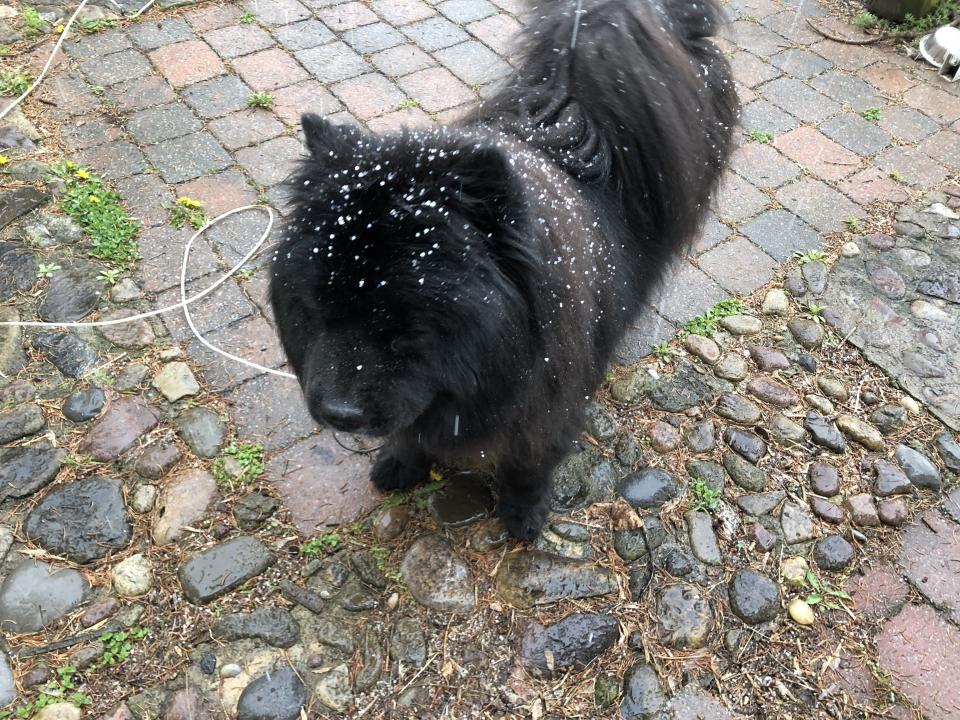Mohawk Valley grappling with graupel: How this week's ice differs from sleet, hail
Wednesday will probably mark the end of graupel season this year.
If you heard loud rain and looked out the window to see tiny balls of ice falling on Monday or Tuesday, then you’ve experienced graupel.
They are tiny ice pellets, often mixed with rain, that look at lot like Dippin’ Dots or Styrofoam packing material and fall when it’s too cold for hail and too warm for sleet, said meteorologist Adam Gill, of the National Weather Service in Binghamton.

Graupel is opaque while sleet and small hailstones are transparent, although bigger hailstones are also opaque because they have more air trapped inside, Gill said.
Monday and Tuesday were perfect graupel weather with rain, temperatures in the 40s and a layer of freezing air hanging low at about 2,000 feet, Gill said. And Wednesday should be just like Tuesday, meaning more graupel is likely, he predicted.
“And then, after that,” he said, “we’ll probably be done for the year.”
More: Oneida County flood mitigation program extends beyond 6-year plan: What it means
More: Flooding brings literary great to Utica for the night: This week in Mohawk Valley history
That cold air hovering low will move away on Thursday and temperatures will warm up at the end of the week, heading into a weekend in the 60s with sunny skies, Gall said.
The last week has been rather wet, even for April, with two to four inches of rain, he said. Sunday was particularly rainy with two inches falling in six hours in some areas, he said.
But if you’re still grappling with the idea of precipitation called graupel, you’re not alone. It doesn’t get as much attention as other icy precipitation: hail, sleet, freezing rain and snow. Not even the unofficial creed of postal workers mentions graupel, just "neither snow nor rain nor heat nor gloom of night."
The word may be new to you, but it is not new, first appearing in a weather report in 1889, according to Merriam-Webster. It comes from the German version of the word which means pearl barley, and is a similar size.
Graupel can fall anywhere in the United States, although it is most common out west in high elevations, Gill said. It doesn’t fall all that often in Central New York.
“It’s most common in the springtime,” Gill said, “when you have that really strong sun while there’s still cold air in place.”
Here’s how Mother Nature makes graupel, according to Gill:
The freezing level in the atmosphere has to be low. In Central New York on Tuesday, it was at about 2,000 feet.
Then you need snow in a cloud with a strong updraft that sends it into that freezing level where it gets covered in ice.
The ground temperature can’t be more than about 45 degrees or the ice would melt before it hit the ground.
Hail, on the other hand, generally forms during a thunderstorm in warm weather when rain gets carried by a strong updraft into thin, colder layer of air where it freezes. Hailstones, which must be at least 0.2 inches in diameter, grow as more liquid freezes onto them, according to the National Severe Storms Laboratory of the National Oceanic and Atmospheric Administration.
Central New York probably has about a dozen or so days a year when the conditions are right for hail, but then strong thunderstorms have to form in those conditions for hail to fall, Gill said. Central New York and northeastern Pennsylvania, the areas covered by the weather service’s Binghamton office, probably get between about five and 10 reports a year of hail bigger than quarters falling. But Binghamton had a storm last year with hailstones more than two inches in diameter, he said.
And there have been reports of hail as big as baseballs in the area, but never, as far as he knows, the grapefruit-sized hail that has fallen other places, Gill said.
Sleet forms when a warm layer of air melts snow and then a cold layer refreezes it as it falls, according to NOAA.
Freezing rain falls as a liquid, passes through a thin layer of air that’s below freezing near the surface, which “supercools” the drops and they freeze when they hit a cold surface.
Water vapor freezes into ice, without ever becoming liquid, to form snow.
After Wednesday, hail season is on its way. Let’s hope we don’t have to grapple with grapefruit hailstones this year.
This article originally appeared on Observer-Dispatch: Graupel hits Mohawk Valley: What to know about icy spring phenomenon

